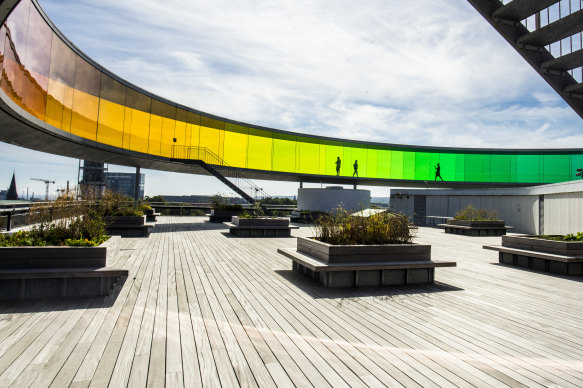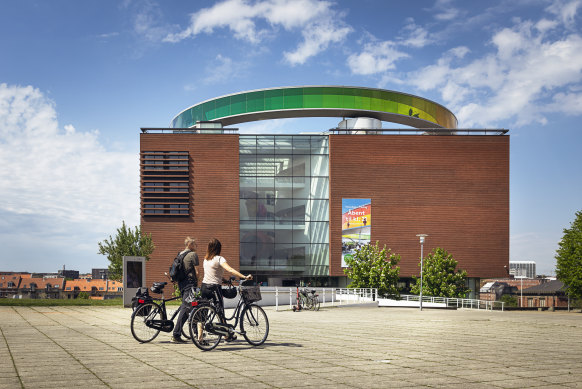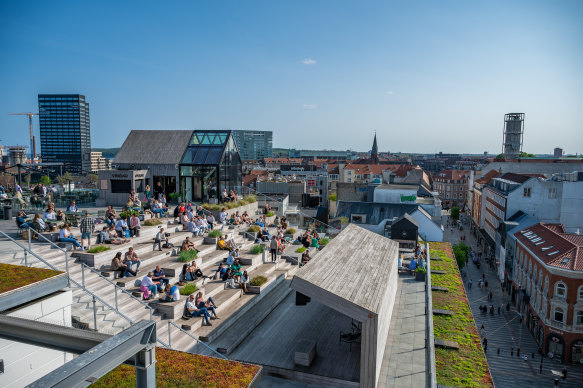I reached the Latin Quarter, a maze of cobbled streets where a woman named Caroline was assembling a bunch of flowers. Nearby, children were carving pumpkins ahead of Halloween. I asked her about the happiness report.
“I think it’s true, I feel like people are very happy,” she said. “There are a lot of facilities people can use. It’s a city, but there’s a lot of nature nearby, there’s the harbour. There’s something for everyone here.”
Yana, who works in a charity shop and has lived in Aarhus all her life, concurred: “Yes, definitely,” she said. “Aarhus has all the conveniences of a small city. It has art, it has music, it has the beach, the forest. Everything.”

Aarhus’s Aros gallery features a circular rainbow walkway on the rooftop.Credit: iStock
In its report, the Happiness Institute considered the five categories of governance, citizens, environment, economy and mobility, within which there were 24 subcategories such as inclusivity and libraries. It does the latter with aplomb. On the harbour, DOKK1 is a spaceship of a library and a feat of modern design, built in 2015. Beneath, I found a futuristic car park which effectively swallows up your car through a trap door and then burps it back out when you return. Beats squeezing into a tight bay at a multi-storey, any day.
There were other clues of a high-functioning society. Futuristic bins transferred money in exchange for recycled coffee cups (a world-first trial of the technology, apparently). In hotels, king-size beds come with two single duvets as standard. On the roads, cyclists had right of way and the taxis were electric. Ubers, however, are banned. Parents held hands with their teenage children who looked too old to have their hands held, but didn’t look at all embarrassed. Because, well, why should they be?
I spoke to other locals who painted a picture of a laid back, liberal, liveable university city which is cheaper and less pretentious than Copenhagen. Something more than one mentioned was “freedom” – many bars still have indoor smoking areas, and the working day ends at 4pm for many people. Yet something that nobody mentioned (maybe they’re too busy being happy to analyse the roots of their own happiness) was that the city’s soul hasn’t been destroyed by tourism. One hotel manager told me that around 80 per cent of their guests were Danish, and this demographic balance was reflected on the streets. Whenever I ordered a coffee or beer, the staff spoke to me in Danish first.
One reason that Aarhus has sidestepped mass tourism could be that it doesn’t have that “where’s my camera” moment that you get at, say, Nyhavn in Copenhagen. That’s not to suggest Aarhus is an ugly city. But for every Art Nouveau facade you have a modernist structure looming nearby. The harbour is concrete and functional, more Maersk than Monaco.
But this, the absence of obnoxious beauty, might just be how the city has managed to sustain its authentic, cosy, lived-in, slightly punky spirit. And this, paradoxically, is exactly what makes Aarhus such a delight to visit.
An elevated experience
I wasn’t entirely truthful with you before. Aarhus does have that chocolate box “scene” for snap-happy tourists, but it’s just done slightly differently here.

Den Gamle By is an open-air museum where actors-in-period-costume recreate medieval life.Credit: iStock
On the outskirts of the centre, Den Gamle By is an open-air museum where some of Denmark’s oldest buildings have been rebuilt, beam-by-beam, to create a miniature old town. It takes you from the medieval times through to the ’90s, from a blacksmiths to Blockbuster. These actors-in-period-costume experiences can be a bit naff, but it’s done well. And maybe, just maybe, having a designated area with entry fee, gift shop, perimeters and all, is better for everyone than the reluctant quasi-Disneyfication of actual old town neighbourhoods happening across Europe.

At Aros, entry to all exhibitions is included in the entry fee.Credit: VisitAarhus
Just around the corner from Den Gamle By is Aarhus’s joint top attraction: Aros, a spiralling art gallery set over 10 floors. All of the exhibitions are included in the entry fee (if only more galleries had the funding to follow this principle), such as the collection of haunting, hyper-real human forms by Ron Mueck. Arguably the top attraction, however, is the spectacular circular rainbow walkway on the rooftop. Who needs a boring old view, when you can make it just a notch happier by running it through a kaleidoscopic filter?
Whenever I had a quiet period during my three days in Aarhus I gravitated to the Latin Quarter, on the edge of the original Viking part of the city. During a walking tour, my guide told me he lived here in the ’60s when it was a “seedy red light district”. But the gentrification of the neighbourhood in the ’70s and ′80s took a deliberately Parisian direction and now it’s filled with coffee shops, independent stores and bistros with tables spilling onto pavements.
The polar opposite in look and feel is the neighbourhood of Aarhus Ø, a brand new harbourfront development that is home to Scandinavia’s tallest building, The Lighthouse, which has a viewing platform on the 44th floor called Aarhus Øje. The floating neighbourhood in its shadow is filled with modern apartment blocks, with freshwater swimming, wakeboarding, saunas, canals and harbourfront cafes serving a new, young population. In true Aarhus style, more than a quarter of the homes are social housing.

Salling Rooftop makes a great spot to enjoy sunset.Credit: iStock
Before the sun went down on my research mission in Aarhus, I sought out the Salling roof garden, hiding in plain sight above the biggest shopping centre in town. The garden is like an Ewok village, set across multiple levels and populated with trees, shrubs and more than a thousand perennial plants. Even during an electric sunset I found a quiet spot to take in the view, with ambient music humming from discreet speakers.
As I watched the city bathe in a cool orange glow, my cheeks dropping in temperature, I reflected: is Aarhus the happiest city on the planet? It certainly gets a lot of things right. But for visitors it also offers a happy reminder: that there is an entire league of second-tier European cities you might have never thought to visit, like Aarhus, slipping quietly under the radar, which will greet you with a warm smile (and warmer cinnamon buns) if you make the trip.
Where to eat and drink
Loading
Aarhus has a coffee scene to rival Copenhagen. La Cabra, in the heart of the Latin Quarter, serves fresh pastries and world-class brews (using water with low mineral content: yes, they take coffee seriously). Stillers, in a former chocolate factory, is another proper roastery.
There are four Michelin-starred restaurants in Aarhus (two-starred Frederikshøj, plus one-starred Gastromé, Restaurant Domestic and Substans). In the Latin Quarter, Mefisto is a charming restaurant with a focus on fresh seafood – their catchphrase is “simple, uncomplicated and cosy” – while Syv Ni13 has a sharing menu of seasonal, minimalistic, thoroughly Nordic-inspired plates. For street food, Banken Food Hall is a buzzy spot with seven kitchens and a cocktail bar.
Where to stay
The Hotel Royal is the grandest accommodation option in town, located in prime position just next to the city’s omnipresent cathedral. The wonderful vintage elevator is the oldest of its kind in Northern Europe; if you find yourself in room 407 (as I did), you’ll be sharing the same bed that Johnny Depp, Madonna and Axl Rose have slept in.
Loading
For a more low-key boutique option, set around a pretty courtyard, Villa Provence feels like a hideaway from the bustle of the city. The attentive and welcoming staff can mix you a cocktail in the candle-lit lounge area, a superlative breakfast is served in the bright dining area downstairs, while antique chandeliers and old French film posters create a sense that you are stepping into another era (let alone country).
Getting there
There aren’t too many airlines that fly into Aarhus but you can fly Ryanair from London Stansted or Scandinavian Airlines from Copenhagen (airlines with connections from Australia to Copenhagen include Emirates, Singapore Airlines, Qatar Airways and Thai Airways). From Aarhus Airport, the 925X bus takes you into the city centre for DKK126 ($27.50); it takes about 50 minutes and you can buy a ticket on board. You can also fly into Billund, slightly further away, and catch the bus in from there (1hr 30m).
The writer was a guest of Hotel Royal and Villa Provence.
The Telegraph, London

